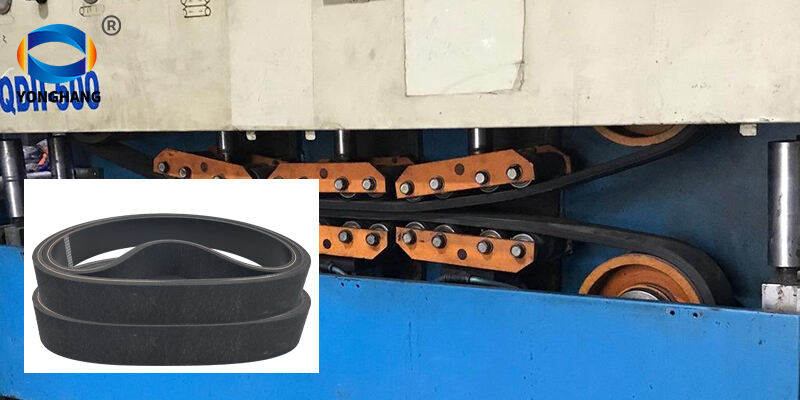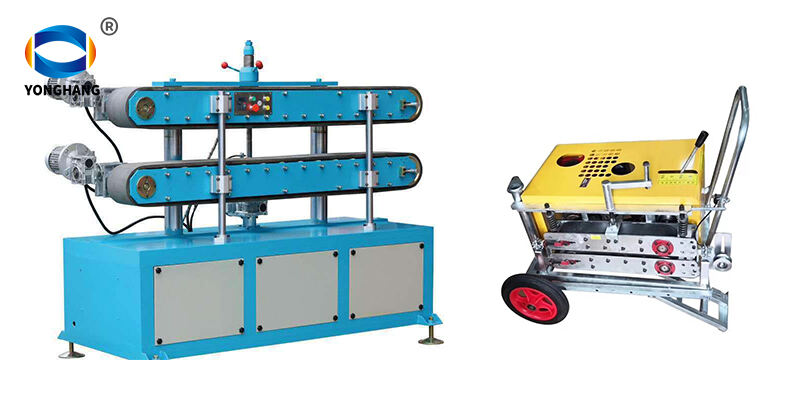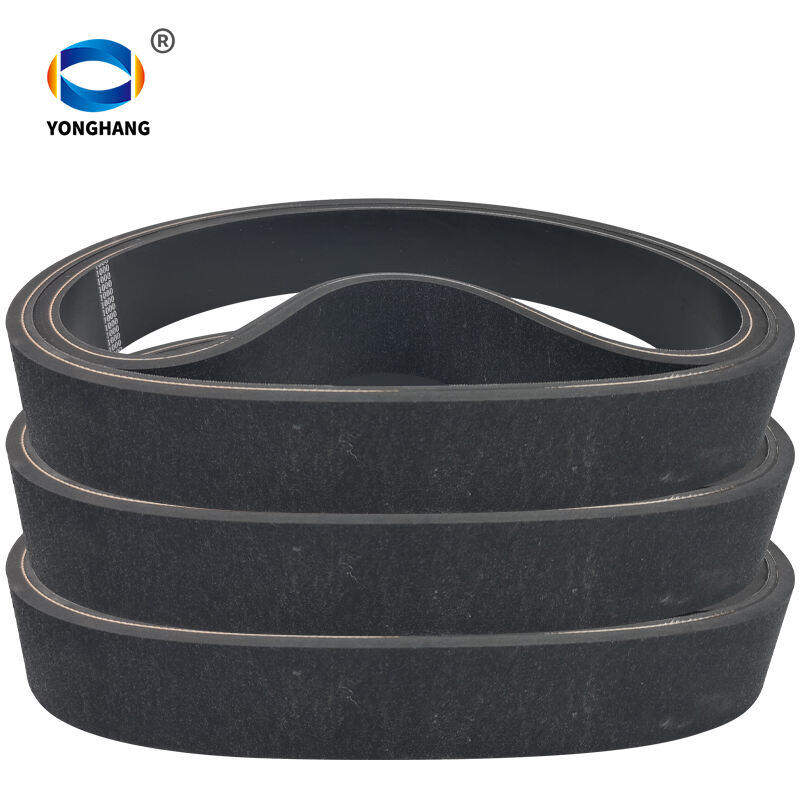The Role of Haul Off Belts in Ensuring Stable Cable Production
How Haul Off Belts Enable Continuous Traction in Cable Lines
Haul off belts maintain consistent tension and speed during cable production, ensuring smooth linear movement through cooling and winding stages. By gripping extruded cables without slippage, they prevent surface defects—research shows optimized traction can reduce imperfections by up to 38% by preserving sheathing integrity.

Key Components and Operational Mechanics of Haul Off Systems
Modern haul off systems integrate three critical elements:
- Reinforced belts with high-friction surfaces
- Precision alignment rollers to prevent lateral drift
- Variable frequency drives (VFDs) for ±0.5% speed accuracy
This configuration supports production speeds exceeding 2,000 meters/minute in high-voltage lines while maintaining diameter tolerances of ±0.1 mm.
The Importance of Synchronization Between Extrusion and Haul-Off Stages
Real-time synchronization between extrusion output and haul off traction prevents stretching or compression defects. Advanced systems use closed-loop feedback controls to adjust belt speeds within 50ms of detecting rate changes. Plants using these systems have reduced annual downtime by 22% by minimizing neck-down and ovality issues (Cable Manufacturing Journal, 2022).

Core Factors Affecting Haul Off Belt Performance and Reliability
Material Composition and Wear Resistance of Haul Off Belts
The lifespan of haul off belts depends on advanced material engineering. High-performance polyurethane and thermoplastic elastomers offer 2.5– greater abrasion resistance than traditional rubber (ISO 14890:2021). Crosslinked polymer chains reduce microfractures under high tension. Key wear indicators include:
- Surface hardness retention after 5,000 operational hours
- Peel resistance under 180° bending cycles
- Chemical stability against lubricants and plasticizers
Certified suppliers provide belts meeting ISO 14890:2021 tensile strength standards, ensuring 0.8% elongation under maximum load (Monsterbelting, 2024).
Precision in Tension Control and Speed Regulation
Optimal cable tension requires ±1.5% speed synchronization between haul off and extrusion systems. Closed-loop servo drives achieve 0.01 N/m tension accuracy via real-time load cell feedback. Over-tensioning by just 7% increases belt wear by 300% and compromises cable concentricity.
Thermal Stability and Environmental Durability in Harsh Conditions
Haul off belts must remain flexible from -40°F to 212°F (-40°C to 100°C). Halogen-free elastomers resist hardening in cold environments and thermal degradation near molten polymers. Oil-resistant formulations reduce replacement frequency by 40% in automotive cable plants (Magnum Industrial, 2024).
Impact of Line Speed on Belt Efficiency and Cable Integrity
| Speed Range | Throughput Gain | Diameter Tolerance |
|---|---|---|
| 0-50 m/min | Baseline | ±0.15 mm |
| 50-120 m/min | 22% | ±0.25 mm |
| 120+ m/min | 34% | ±0.4 mm |
High-speed operation above 120 m/min increases heat generation by 180%, requiring active cooling to prevent jacket deformation. Most telecom lines cap speeds at 90 m/min to balance yield and dimensional accuracy.
Common Performance Issues and Their Impact on Cable Quality
Slippage and Inconsistent Traction: Causes and Cable Defects
Belt slippage causes irregular tension, leading to conductor ovality ( 0.5% diameter variation in 22% of cases) and uneven sheathing. A 2023 friction study found improperly tensioned belts increase surface abrasion by 18%, weakening insulation and dielectric performance. Contamination from PVC residue or worn grooves exacerbates microslip events, often undetected until concentricity tests fail.
Measuring Performance Drift During Extended Production Runs
Line speed changes need close watching too, ideally keeping them within about half a meter per minute difference. Motor current patterns are also important indicators for spotting wear and tear before it becomes serious. According to recent industry data from wire and cable manufacturers, around three quarters of facilities that started tracking torque trends saw their scrap levels drop by roughly forty percent over those still relying on fixing problems after they happen. Things tend to go downhill faster after machines hit about eight hundred operating hours. When belt temperatures climb past seventy degrees Celsius or so, the thermoplastic components start losing their rigidity which leads to premature failure.
Case Study: Downtime Reduction Through Proactive Belt Maintenance in European Plants
One German manufacturing plant rolled out a maintenance schedule that included checking tension every two weeks and cleaning grooves once a week across their 12 extrusion lines. The result? They managed to slash unexpected stoppages by around two thirds over just half a year. For wear analysis, the team started using 3D profilometry equipment which gave them much better insights into how parts were degrading. As a bonus, this approach stretched belt lifespan from roughly 1,200 to nearly 1,800 operating hours, all while keeping concentricity below that critical 0.03 mm threshold needed for those high performance 5G coaxial cables. Financially speaking, each production line saved about 38 grand a year, and overall product quality on first pass jumped to an impressive 99.4%.
Design Innovations for High-Performance Haul Off Belt Systems
Optimizing Surface Grip to Protect Cable Sheathing
Laser-etched patterns and hybrid composites balance traction and jacket protection. Silica-reinforced polymers reduce friction coefficients by 18–22% compared to rubber (Material Science Quarterly 2023), preventing micro-abrasions on sensitive insulation. Micro-textured zones maintain grip stability above 120 meters/minute without damaging surface finish.
Belt Geometry and Uniform Contact Pressure Distribution
Asymmetric v-profile designs ensure 94% contact efficiency across diameters from 5mm to 150mm. Computer-optimized curvature compensates for thermal expansion, keeping pressure variations below ±8% during continuous operation. Data from six automotive wire plants show these geometries cut diameter tolerance breaches by 67% versus flat belts.
Modular and Service-Friendly Designs for Minimal Downtime
Quick-release segments allow full belt section replacements in under 12 minutes. A 2023 industry study found modular architectures reduced planned maintenance time by 58% in fiber optic lines. Standardized interfaces let facilities retain 85% of legacy components during upgrades.
Integration with Real-Time Monitoring and Automation
IoT-enabled belts with embedded strain gauges feed data to predictive algorithms, forecasting wear with 92% accuracy. Facilities using AI-driven platforms report 30% fewer unplanned stops (World Bank 2023), with synchronization errors between extrusion and haul-off dropping below 0.3% in smart manufacturing setups.
Future Trends in Haul Off Belt Technology and Smart Manufacturing
Smart Sensors and IoT-Driven Predictive Maintenance
Modern IoT sensors track things like tension levels, wear patterns, and alignment issues as they happen, stopping diameter changes from going past the ±0.5% threshold. When these monitoring systems detect problems, they give operators warning signs anywhere from 48 to 72 hours ahead of actual failures. According to World Bank research from 2023, this early warning system cuts down on equipment downtime by around 30% in facilities using predictive maintenance approaches. The bigger picture involves centralized IIoT platforms that connect belt performance data with extrusion settings, making automatic adjustments to the traction force applied. Looking at industry trends, companies adopting these smart belt technologies typically see an 18% drop in wasted energy simply because the systems optimize friction dynamically during operation.
Sustainable Materials and Recyclable Belt Construction
Bio based polyurethanes combined with recycled rubber actually perform just as well as regular materials when it comes to lasting power even at temperatures around 120 degrees Celsius during constant use. And best part? They cut down on carbon emissions by about forty percent throughout their whole life cycle. The modular design approach means companies can replace just parts instead of throwing everything away. With closed loop recycling systems, manufacturers manage to recover nearly ninety two percent of all materials used. Last year there was this test project in 2024 where they made cables from algae based polymers that lasted over a thousand hours without any damage to the outer layer, which is exactly what telecom operators need for their precision work. All these developments really help move things forward toward those EU sustainability targets too since plant derived compounds have finally reached the strength standards required by ISO 15236 1, exceeding twenty five mega pascals in tensile tests.
FAQ Section
What are haul off belts in cable production?
Haul off belts are components used in cable production to maintain consistent tension and speed, ensuring smooth movement through various stages without defects.
How do haul off belts affect cable quality?
They grip extruded cables firmly, preventing slippage. By doing so, haul off belts reduce surface defects and preserve sheathing integrity, improving cable quality.
What materials are used for haul off belts?
High-performance polyurethane and thermoplastic elastomers are commonly used for their durability and abrasion resistance, outperforming traditional rubber materials.
Table of Contents
- The Role of Haul Off Belts in Ensuring Stable Cable Production
- Core Factors Affecting Haul Off Belt Performance and Reliability
- Common Performance Issues and Their Impact on Cable Quality
- Design Innovations for High-Performance Haul Off Belt Systems
- Future Trends in Haul Off Belt Technology and Smart Manufacturing
- FAQ Section

 EN
EN
 AR
AR
 HR
HR
 DA
DA
 NL
NL
 FR
FR
 DE
DE
 EL
EL
 HI
HI
 IT
IT
 JA
JA
 KO
KO
 NO
NO
 PL
PL
 PT
PT
 RO
RO
 RU
RU
 ES
ES
 TL
TL
 IW
IW
 ID
ID
 SR
SR
 SK
SK
 UK
UK
 VI
VI
 TH
TH
 TR
TR
 AF
AF
 MS
MS
 IS
IS
 HY
HY
 AZ
AZ
 KA
KA
 BN
BN
 LA
LA
 MR
MR
 MY
MY
 KK
KK
 UZ
UZ
 KY
KY
